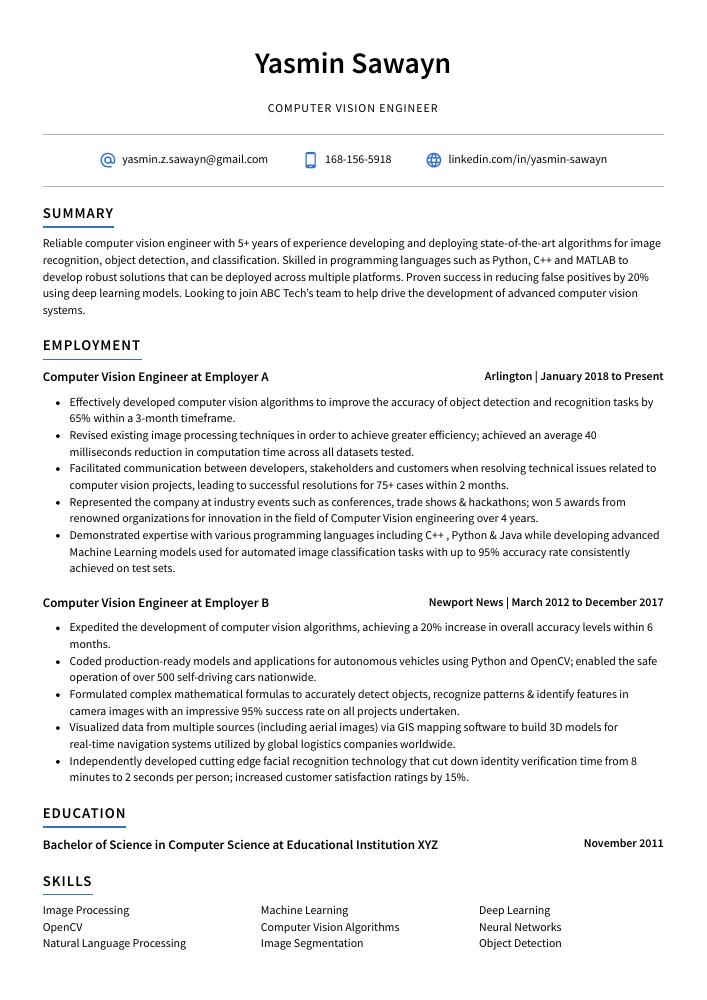Computer Vision Engineer Resume Guide
Computer Vision Engineers develop algorithms and systems to interpret digital images and videos. They use machine learning, artificial intelligence, image processing techniques, and computer vision technology to create solutions for a variety of applications such as facial recognition, object detection/recognition or autonomous vehicle navigation.
Your knowledge of computer vision technology and algorithms is unmatched. But potential employers don’t know it yet, so to make them aware of your skillset you must write a resume that catches their eye.
This guide will walk you through the entire process of creating a top-notch resume. We first show you a complete example and then break down what each resume section should look like.
Table of Contents
The guide is divided into sections for your convenience. You can read it from beginning to end or use the table of contents below to jump to a specific part.
Computer Vision Engineer Resume Sample
Yasmin Sawayn
Computer Vision Engineer
[email protected]
168-156-5918
linkedin.com/in/yasmin-sawayn
Summary
Reliable computer vision engineer with 5+ years of experience developing and deploying state-of-the-art algorithms for image recognition, object detection, and classification. Skilled in programming languages such as Python, C++ and MATLAB to develop robust solutions that can be deployed across multiple platforms. Proven success in reducing false positives by 20% using deep learning models. Looking to join ABC Tech’s team to help drive the development of advanced computer vision systems.
Experience
Computer Vision Engineer, Employer A
Arlington, Jan 2018 – Present
- Effectively developed computer vision algorithms to improve the accuracy of object detection and recognition tasks by 65% within a 3-month timeframe.
- Revised existing image processing techniques in order to achieve greater efficiency; achieved an average 40 milliseconds reduction in computation time across all datasets tested.
- Facilitated communication between developers, stakeholders and customers when resolving technical issues related to computer vision projects, leading to successful resolutions for 75+ cases within 2 months.
- Represented the company at industry events such as conferences, trade shows & hackathons; won 5 awards from renowned organizations for innovation in the field of Computer Vision engineering over 4 years.
- Demonstrated expertise with various programming languages including C++ , Python & Java while developing advanced Machine Learning models used for automated image classification tasks with up to 95% accuracy rate consistently achieved on test sets.
Computer Vision Engineer, Employer B
Newport News, Mar 2012 – Dec 2017
- Expedited the development of computer vision algorithms, achieving a 20% increase in overall accuracy levels within 6 months.
- Coded production-ready models and applications for autonomous vehicles using Python and OpenCV; enabled the safe operation of over 500 self-driving cars nationwide.
- Formulated complex mathematical formulas to accurately detect objects, recognize patterns & identify features in camera images with an impressive 95% success rate on all projects undertaken.
- Visualized data from multiple sources (including aerial images) via GIS mapping software to build 3D models for real-time navigation systems utilized by global logistics companies worldwide.
- Independently developed cutting edge facial recognition technology that cut down identity verification time from 8 minutes to 2 seconds per person; increased customer satisfaction ratings by 15%.
Skills
- Image Processing
- Machine Learning
- Deep Learning
- OpenCV
- Computer Vision Algorithms
- Neural Networks
- Natural Language Processing
- Image Segmentation
- Object Detection
Education
Bachelor of Science in Computer Science
Educational Institution XYZ
Nov 2011
Certifications
Certified Computer Vision Professional
Society of Computer Vision Professionals
May 2017
1. Summary / Objective
A resume summary or objective for a computer vision engineer should highlight your technical skills, knowledge of the latest technologies, and experience in developing innovative solutions. You could mention any relevant certifications or awards you have earned, such as an OpenCV certification or first place at a hackathon. You can also include details about how you solved complex problems with machine learning algorithms and implemented successful projects using deep learning techniques.
Below are some resume summary examples:
Amicable and experienced computer vision engineer with 7+ years of experience developing state-of-the-art deep learning models for various applications. Adept at designing and testing algorithms to improve the performance, accuracy, speed, scalability and reliability of AI systems deployed in production environments. Seeking an opportunity to join ABC Tech as a Computer Vision Engineer where I can contribute my knowledge and expertise towards building efficient solutions.
Well-rounded computer vision engineer with 5+ years of experience in developing and deploying computer vision algorithms for various applications. Proven track record of leading the development of cutting-edge solutions for autonomous vehicles, facial recognition systems, 3D reconstruction & tracking technologies. Skilled at working under tight deadlines while maintaining quality standards on projects involving multiple stakeholders from different areas of expertise.
Committed computer vision engineer with 5+ years of experience in developing and deploying computer vision algorithms for medical imaging, autonomous vehicles, and image recognition. Skilled in C++/Python programming languages as well as deep learning frameworks such as PyTorch, TensorFlow, and OpenCV. Experienced in object detection & tracking techniques like YOLOv3. At XYZ Company achieved an accuracy rate of 95% on text extraction from images using OCR technology.
Enthusiastic computer vision engineer with three years of experience in developing and deploying computer vision applications. Skilled at researching, designing, coding, integrating and debugging software for autonomous vehicles. Expertise includes deep learning architectures such as CNNs and RNNs, OpenCV libraries and object detection frameworks like YOLOv3. Proven track record of successful projects that have increased efficiency by an average of 30%.
Energetic computer vision engineer with 5+ years of experience developing deep learning-based applications in image/video analysis and object recognition. Proven ability to create innovative solutions that drive customer value. At XYZ, led a successful effort to develop an AI-powered facial recognition system for retail stores, improving accuracy by 37%. Looking forward to joining ABC Tech’s team as the new Computer Vision Engineer.
Proficient computer vision engineer with 7+ years of experience developing deep learning models for a variety of applications. Skilled in using TensorFlow, PyTorch, and OpenCV to create image classification systems and object detection algorithms. Seeking to leverage expertise in computer vision engineering at ABC Tech to develop innovative solutions that optimize performance and accuracy across various projects.
Diligent computer vision engineer with 5+ years of experience in the development and implementation of computer vision algorithms. Skilled at creating, deploying, and maintaining models for object detection, segmentation, tracking/motion analysis using deep learning techniques such as Convolutional Neural Networks (CNNs). Experienced in leading projects from beginning to end while managing a team of engineers.
Detail-oriented computer vision engineer with 7+ years of experience developing computer vision applications and algorithms. Expertise in object detection, image segmentation, feature extraction, data augmentation, and neural networks. Seeking to join ABC Tech for the opportunity to apply my skills in deep learning technologies and create innovative solutions.
2. Experience / Employment
The work history/experience section is where you provide details on your past employment. This should be written in reverse chronological order, meaning the most recent job is listed first.
When writing this section, it’s best to stick to bullet points; doing so allows the reader to quickly digest what you have said. You want each point to include a detail of what you did and any quantifiable results that were achieved as a result of your work.
For example, instead of saying “Developed computer vision algorithms,” you could say “Designed and implemented object detection algorithms using deep learning techniques which improved accuracy by 10%.”
To write effective bullet points, begin with a strong verb or adverb. Industry specific verbs to use are:
- Designed
- Implemented
- Optimized
- Analyzed
- Programmed
- Trained
- Coded
- Debugged
- Tested
- Monitored
- Documented
- Researched
- Visualized
- Automated
- Integrated
Other general verbs you can use are:
- Achieved
- Advised
- Assessed
- Compiled
- Coordinated
- Demonstrated
- Developed
- Expedited
- Facilitated
- Formulated
- Improved
- Introduced
- Mentored
- Participated
- Prepared
- Presented
- Reduced
- Reorganized
- Represented
- Revised
- Spearheaded
- Streamlined
- Structured
- Utilized
Below are some example bullet points:
- Resourcefully developed computer vision algorithms to recognize objects and faces in images, resulting in a 15% increase of accuracy over the previous system.
- Coordinated engineering teams to design, test and implement new software solutions for object tracking using machine learning techniques; achieved 3x faster processing speeds than existing systems.
- Participated in hands-on coding projects with Python & C++ libraries to build deep learning models that identified patterns within data sets accurately at 98%.
- Advised business stakeholders on best practices when integrating automated facial recognition into production processes, reducing implementation time by 30 hours per project cycle.
- Achieved milestones ahead of schedule by leveraging end-to-end automation technologies such as OpenCV & TensorFlow across image acquisition pipelines; improved efficiency by 25%.
- Integrated computer vision algorithms into existing software systems, leading to a 25% increase in accuracy of facial recognition and object detection.
- Debugged code related to computer vision projects such as 3D depth mapping, motion tracking and image segmentation; reduced bug-related downtime hours by 40%.
- Meticulously crafted engineering prototypes using various machine learning models for image processing tasks like classification and regression; improved overall model performance by 15%.
- Streamlined the development process of deep learning applications used in autonomous cars with an optimized workflow that decreased production time per project by 20%.
- Compiled customer requirements into detailed technical specifications for successful delivery of computer vision solutions on time and within budget; increased client satisfaction ratings from 75% to 95%.
- Presented research findings at 3 international computer vision conferences, resulting in the successful publication of a paper on image processing techniques.
- Improved accuracy of facial recognition algorithms by 10% through optimized deep learning models and convolutional neural networks (CNNs).
- Optimized existing object detection systems within a production environment to ensure faster response times; achieved 40% reduction in latency for real-time applications.
- Efficiently utilized resources such as GPUs and cloud computing services to develop scalable machine learning solutions with high performance rates over extended periods of time without any downtime or crashes reported in the system logs.
- Mentored junior engineers on topics such as digital signal processing (DSP) fundamentals, feature extraction methods and advanced CNN architectures, leading to an improved understanding among team members regarding image analysis concepts & principles that resulted in greater project efficiency overall.
- Tested and evaluated the accuracy of computer vision algorithms in identifying objects, achieving an average precision rate of 98%.
- Trained and deployed several deep learning models for object detection on real-time video streams, leading to a 30% reduction in false positives.
- Thoroughly analyzed data sets from various sources such as sensors and cameras to identify patterns & anomalies; developed custom software tools that saved 200+ hours annually.
- Introduced a new approach to image segmentation using convolutional neural networks (CNNs) which improved recognition accuracy by 40% compared with traditional methods used before.
- Structured the workflow process for integrating natural language processing (NLP) into existing computer vision systems; completed projects within tight budget constraints while meeting all deadlines set forth by clients or upper management.
- Monitored the performance of computer vision models using deep learning algorithms, resulting in improved accuracy by 8%.
- Prepared datasets for computer vision training and ensured that all data was properly labeled to optimize efficiency; decreased development time by 15 hours per week.
- Spearheaded the implementation of new image processing techniques to enhance the quality of images used for facial recognition applications, increasing authentication rate by 23%.
- Reduced manual efforts related to object detection tasks through automation with Python & Tensorflow libraries; saved over 10 work hours per project on average.
- Actively participated in research projects focused on identifying objects within videos using advanced camera systems and neural networks; achieved an overall accuracy score of 92% after three months’ trials & tests.
- Developed and implemented computer vision algorithms that automated the detection of objects in images and videos with 95% accuracy.
- Consistently improved existing machine learning models by 5-10%, allowing for more accurate object recognition results in a shorter amount of time.
- Researched new methods to improve image processing quality, increasing overall performance speed by 20%.
- Programmed deep neural networks using Python and TensorFlow to recognize patterns from digital images; achieved 80+ frames per second when working on large datasets consisting of 10,000+ samples each session.
- Assessed various open source libraries related to computer vision development, resulting in shortened project completion times by over 40 hours total during Q1 & Q2 periods this year alone.
- Reorganized existing computer vision algorithms and models to improve image processing accuracy by 25%; saving up to 2 hours of manual labor per task.
- Automated the detection, classification and segmentation of images using advanced Python programming techniques; reduced errors in facial recognition by 15%.
- Reliably developed high-performance artificial intelligence (AI) systems for object tracking, optical character recognition (OCR), autonomous vehicle navigation and other complex applications.
- Designed a range of custom deep learning networks that achieved over 95% accuracy on multi-label text classification tasks with limited training data samples (+200).
- Utilized machine learning frameworks such as TensorFlow, Keras & Scikit Learn to implement real-time feature extraction from digital media inputs; increased model efficiency by 32%.
- Analyzed, developed and implemented computer vision algorithms to detect, recognize and classify objects in images with 97% accuracy, resulting in a 20% reduction of false positives.
- Implemented cutting-edge deep learning models for object detection tasks using convolutional neural networks (CNNs) that achieved an average recall rate of 85%.
- Documented code changes, results from experiments and other technical details regarding the development process; maintained clean version control systems to ensure smooth project execution.
- Accurately tested novel approaches on large datasets before deployment into production environment, reducing deployment errors by 30%.
3. Skills
Even though two organizations are hiring for the same role, the skillset they want an ideal candidate to possess could differ significantly. For instance, one may be on the lookout for an individual who is proficient in OpenCV, while another may want someone with experience working on TensorFlow.
It is therefore essential to tailor the skills section of your resume for each job that you are applying for. This will help ensure that it passes through applicant tracking systems and gets seen by a human recruiter or hiring manager.
In addition to just listing relevant skills here, you should also discuss them in more detail in other sections such as the summary or work experience areas.
Below is a list of common skills & terms:
- Computer Vision Algorithms
- Deep Learning
- Image Processing
- Image Recognition
- Image Segmentation
- Machine Learning
- Natural Language Processing
- Neural Networks
- Object Detection
- OpenCV
4. Education
Including an education section on your resume will depend on how far along you are in your career. If you just graduated and have no work experience, mention your education below the resume objective. However, if you have significant work experience to showcase, omitting an education section is perfectly fine.
If an education section is included, focus on courses or subjects related to computer vision engineering that can help demonstrate your qualifications for the role.
Bachelor of Science in Computer Science
Educational Institution XYZ
Nov 2011
5. Certifications
Certifications are a great way to demonstrate your knowledge and proficiency in certain areas. They can also show potential employers that you are serious about staying up-to-date with industry trends and have taken the initiative to invest in yourself professionally.
When applying for jobs, be sure to include any certifications relevant to the position on your resume as they will give you an edge over other applicants who may not have them.
Certified Computer Vision Professional
Society of Computer Vision Professionals
May 2017
6. Contact Info
Your name should be the first thing a reader sees when viewing your resume, so ensure its positioning is prominent. Your phone number should be written in the most commonly used format in your country/city/state, and your email address should be professional.
You can also choose to include a link to your LinkedIn profile, personal website, or other online platforms relevant to your industry.
Finally, name your resume file appropriately to help hiring managers; for Yasmin Sawayn, this would be Yasmin-Sawayn-resume.pdf or Yasmin-Sawayn-resume.docx.
7. Cover Letter
Including a cover letter with your resume is a great way to show potential employers that you are serious about the job. This document usually consists of 2 to 4 paragraphs and serves as an opportunity for you to explain why you believe yourself to be the perfect fit for the role.
Not all jobs require applicants submit cover letters, but it’s highly recommended if you want your application stand out from others. By writing one, recruiters can gain better insights into who you are and what makes you unique as a professional.
Below is an example cover letter:
Dear Charlene,
I am writing to apply for the Computer Vision Engineer position at [company name]. With experience in both software engineering and computer vision, as well as a PhD in Electrical Engineering, I believe I have the skills and knowledge your company is looking for.
At my previous job, I worked on a team that developed a computer vision system for autonomous vehicles. This involved working with sensors such as cameras and lidar, as well as developing algorithms for object detection, tracking, and recognition. My experience with both hardware and software makes me confident that I can contribute to your company’s success.
In addition to my work experience, I have also conducted research in the field of computer vision. My doctoral dissertation was on image reconstruction from compressive measurements, which is an important problem in many imaging applications. I am confident that my research experience will be beneficial to your company.
I am excited about the possibility of joining your team and contributing to your company’s success. If you have any questions or would like more information about my qualifications, please do not hesitate to contact me at [phone number] or [email address]. Thank you for your time and consideration.
Sincerely,
Yasmin
Computer Vision Engineer Resume Templates
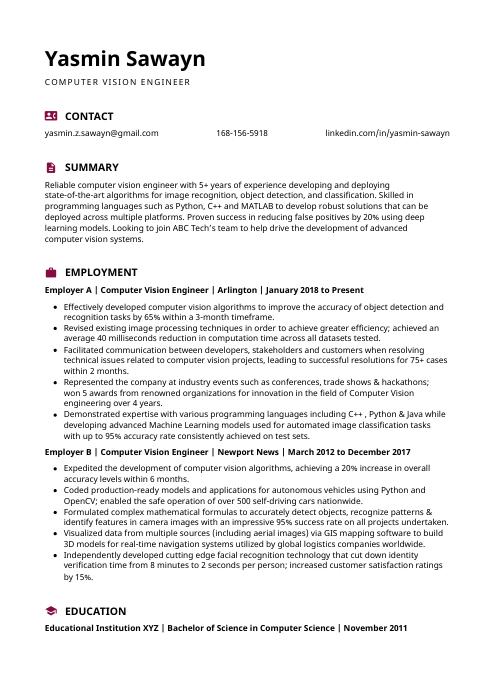 Hoopoe
Hoopoe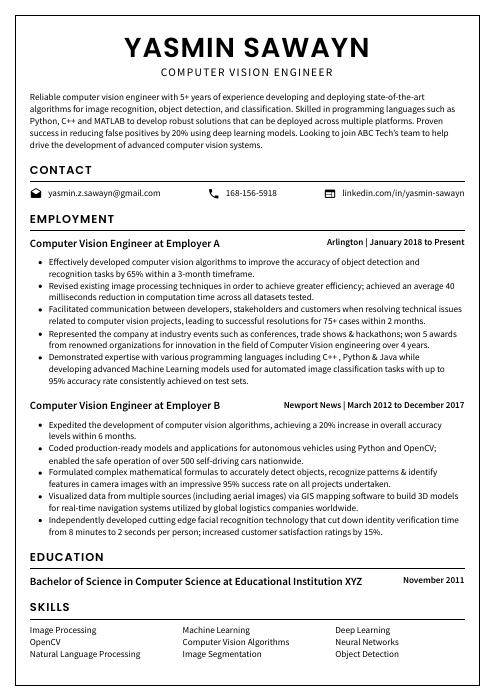 Cormorant
Cormorant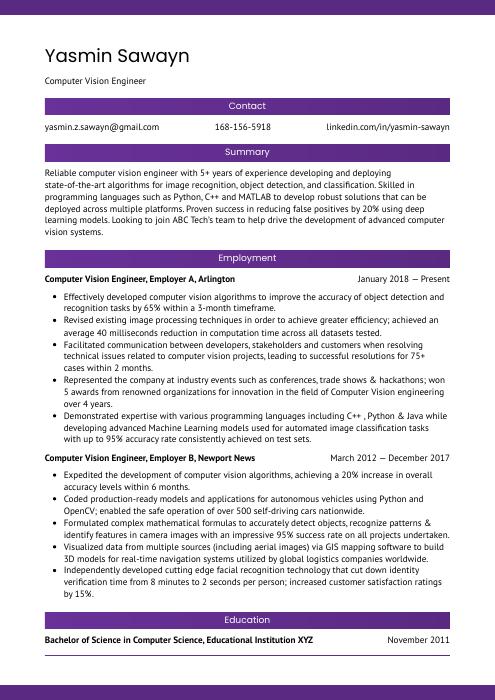 Jerboa
Jerboa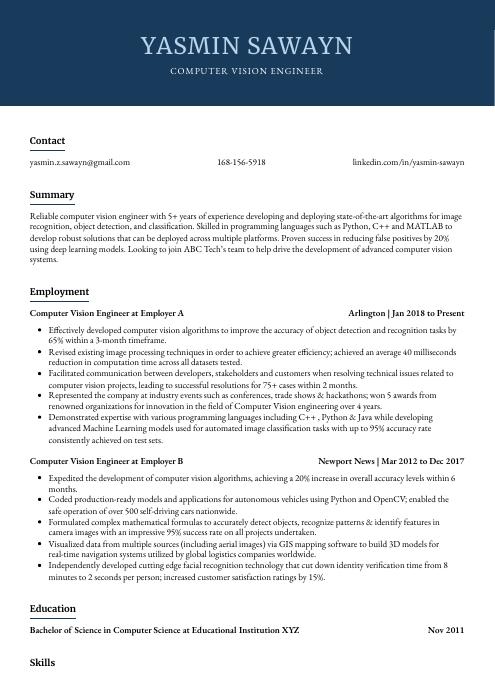 Bonobo
Bonobo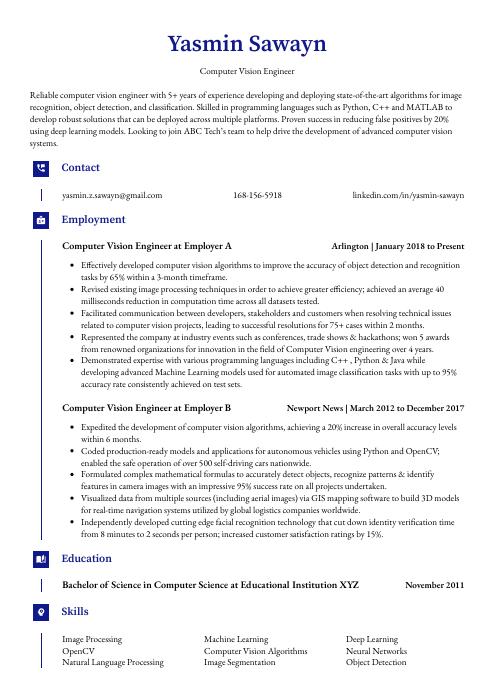 Gharial
Gharial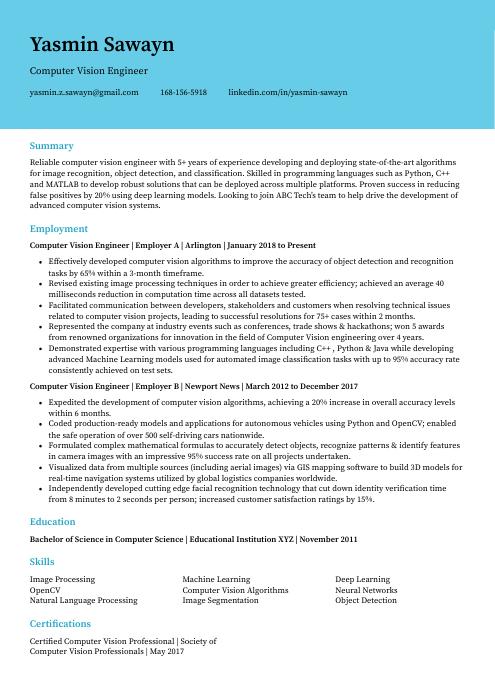 Dugong
Dugong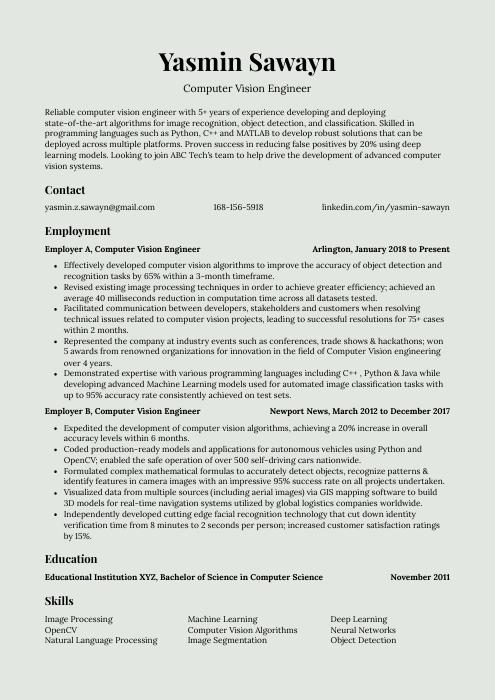 Saola
Saola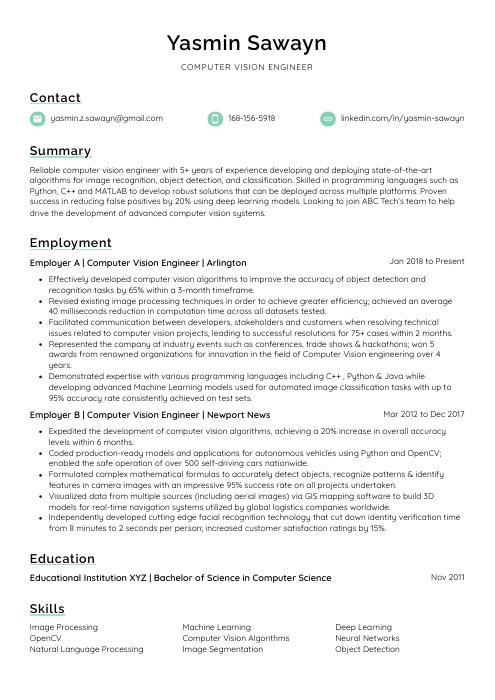 Lorikeet
Lorikeet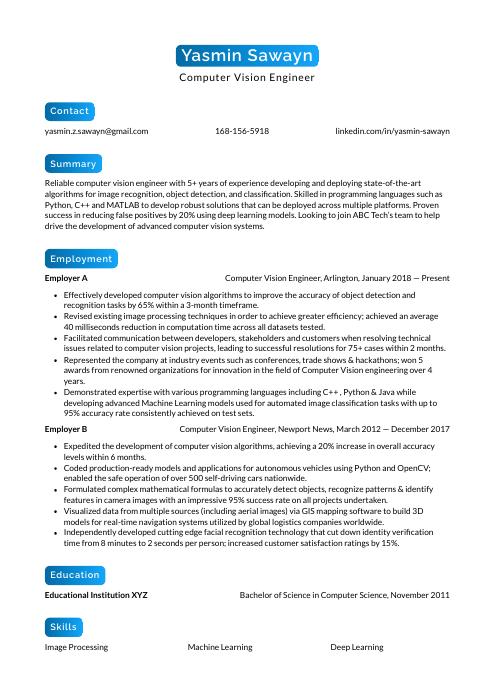 Kinkajou
Kinkajou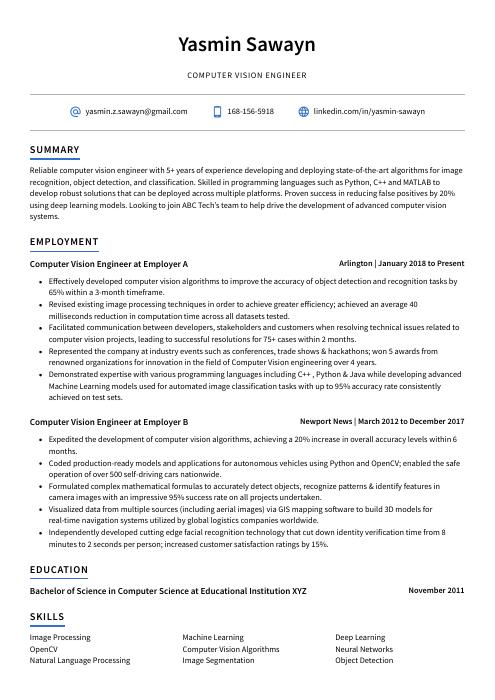 Axolotl
Axolotl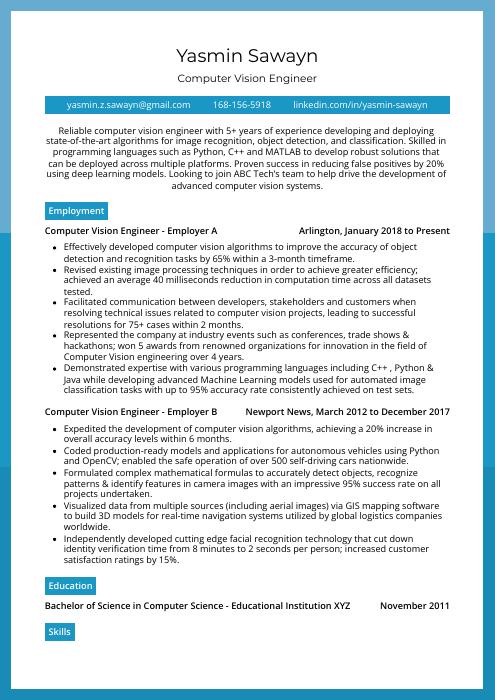 Rhea
Rhea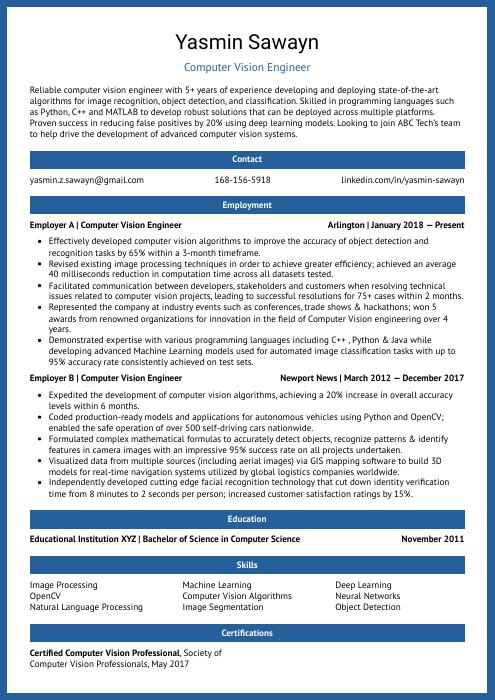 Ocelot
Ocelot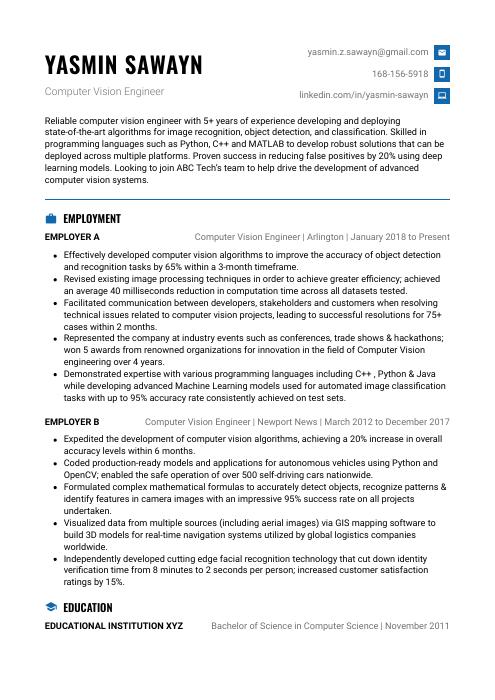 Echidna
Echidna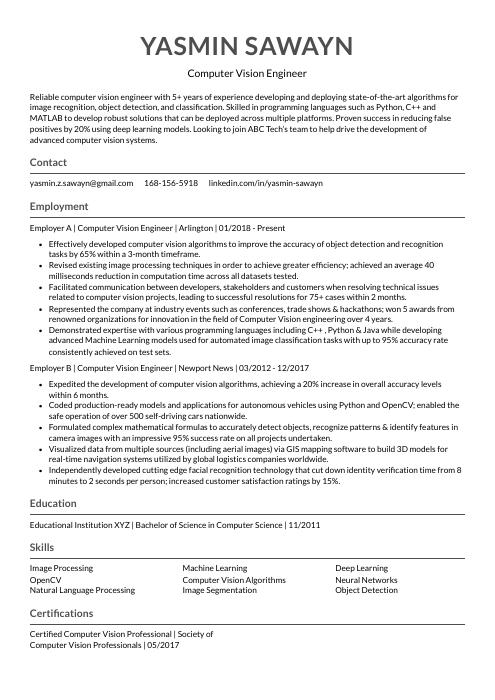 Indri
Indri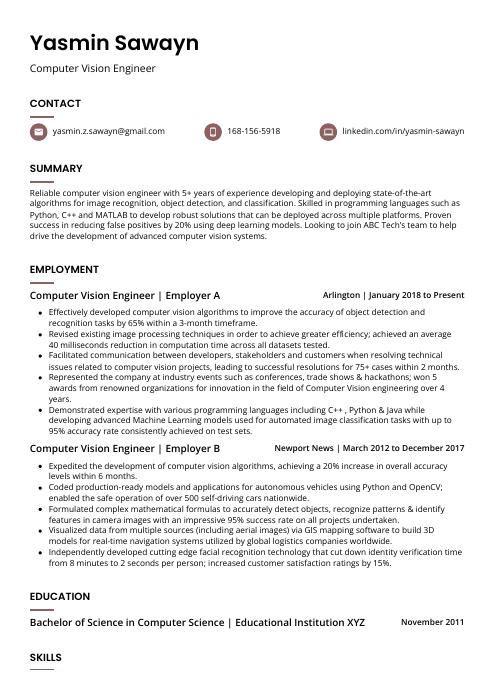 Fossa
Fossa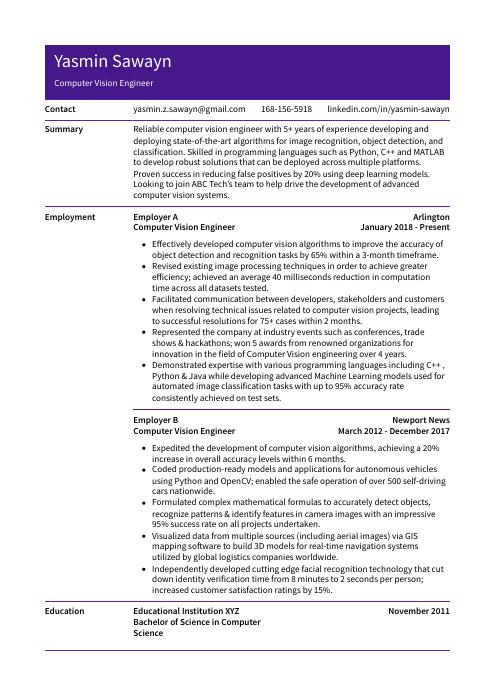 Pika
Pika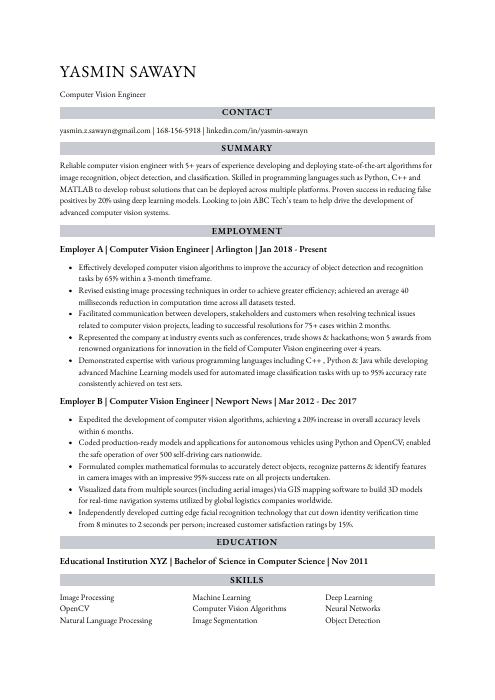 Numbat
Numbat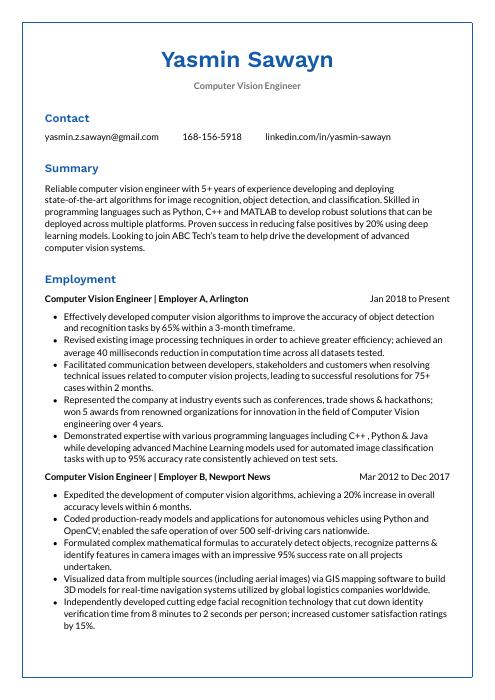 Markhor
Markhor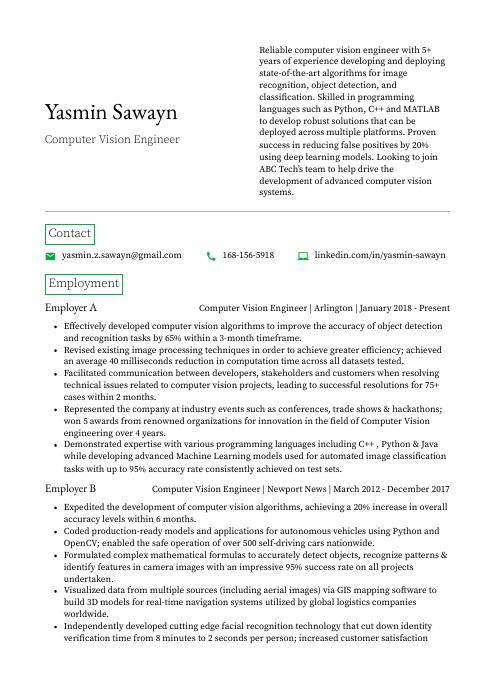 Quokka
Quokka Rezjumei
Rezjumei
